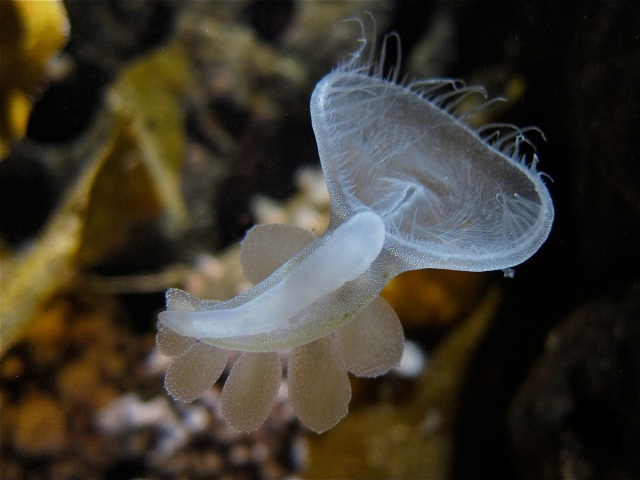TAXONOMY
Phylum: Mollusca
Class: Gastropoda,
Order: Nudibranchia (sea slugs)
Family Tethydidae
Genus/ species: Melibe leonina
YouTube VIDEO http://youtu.be/Xe2bM2kKm-U
GENERAL CHARACTERISTICS: Color a translucent gray, greenish-gray, or yellowish-gray, with opaque brown hepatic diverticula. Melibe leonina has 4-6 pairs of large, leaflike or paddlelike cerata in two rows down its dorsum and a large oral hood with two rows of filiform tentacles around its margin.

Length up to 102 mm long (4 in), 25 mm (1 in) wide, and 51 mm (2 in) across the expanded oral hood.
DISTRIBUTION/HABITAT: West coast of North America from Alaska to Baja California in eelgrass beds, kelp (especially Macrocystis) beds, harbors. When swimming it is usually upside-down, and undulates back and forth.
DIET: M. leonina feeds on Copepods, amphipods, and ostracods, as well as small post-larval mollusks. They firmly attache itself to a kelp blade and then sweeps its raised hood downward or to the side. When food lands on the lower surface of the hood, the melibe sweeps together the two sides of the hood, and its fringing tentacles lock in the prey. The hood contracts to force the captured food into the M. leonine’s mouth.
REPRODUCTION and DEVELOPMENT: M. leonine are hermaphrodites (they have both male and female sexual organs), and fertilization is internal. The animal can lay as many as 30,000 eggs, which are enclosed in a long, gelatinous ribbon.
REMARKS: Noxious secretions of the melibe smell like watermelon, according to aquarists. They are gregarious animals and probably use it to keep together as well as for defense. Most predators avoid the noxious secretions of nudibranchs; but the kelp crab is an exception.
This species has been used for neurological research.
References
California Academy of Sciences, Steinhart Aquarium, Water is Life 2019
Ron’s WordPress Shortlink wp.me/p1DZ4b-fW
Ron’s flickr www.flickr.com/photos/cas_docents/sets/72157608597736188/
Monterey Bay Aquarium www.montereybayaquarium.org/animal-guide/invertebrates/me…
EOL eol.org/pages/454874/details























